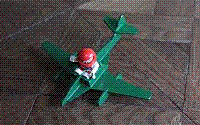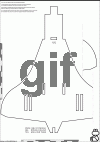
Model building
Supersonic Airliner

www.e-rokodelnica.si
 Model building | Supersonic Airliner |  www.e-rokodelnica.si |
This page describes a model of a supersonic airliner made of plywood. The airplane model is designed to learn sawing with a fretsaw and other skills. Since the model is not difficult to make, it is suitable for beginners. The model airplane is not a flying one, but it can be used as a toy, because it has seats for passengers. Because of small parts, it (as a toy) is not suitable for children under three years.

| 
| 
|
It is not allowed to use this document or part of it for commercial purposes. The exception is teachers who may use it at their own classes.
 |
We cut parts of the aircraft out of 4 mm thick plywood first. We find patterns of the parts in files that are pointed at by links in figure 1. We print the drawings and transfer the patterns to the plywood. A procedure is described in greater detail in the page Transferring Shapes of Parts to Plywood.
  |
  |
Figure 1: Parts of the Aircraft
In the drawings, each pattern is drawn only once. It is written in brackets, how many parts of each pattern we need to cut out. We need four engines 10, two fuselage sides 2... The wing 1 is too large to be drawn in one piece. The two pieces must be joined when we transfer the pattern to plywood.
We cut all parts out of plywood as precisely as possible. We can find some tips to help us sawing in the page Using of a Fretsaw. After that, we drill holes in the holders 8 and nose 12. Through the holes with a diameter A, we insert a wire to make a hinge for the droop nose. Therefore, the diameter A depends on the diameter of wire. We insert a rubber string through the hole with diameter B. The string holds the aircraft's nose high. The diameter B should be something like 3 mm (1/8 in) or 4 mm.
Finally, we sand the parts to remove cutting marks.
 |
When we have prepared all the parts, we start gluing. on the wing 1, we make a cabin, which consists of parts 2, 4, 5, 6 and 7. To the back side of the cabin, a tail 3 is affixed. Then, we wait for the glue to dry.

Figure 2: Assembling of the aircraft, step 1
On the front side of a cockpit, the two holders 8 are affixed. We must take care that there is sufficient space between the holders for the nose 12.

Figure 3: Assembling of the aircraft, step 2
Then, we assemble landing gears. First, we glue the front wheel 9. The main gears 11 are affixed together with engines 10 so that engines hold the gears on place. Be careful to affix main gears parallel.

Figure 4: Assembling of the aircraft, step 3
The gluing is now complete. We sand and paint the aircraft.
When the paint is dry, we affix the nose 12 to the fuselage with a piece of wire 13 so that it can move.

Figure 5: Assembling of the aircraft, step 4
The rubber string 13 is drawn through the hole in the aircraft nose 12 and hooked to the holders in the front of cockpit. The string must be tense enough to hold the aircraft nose in the drooped or raised position.

Figure 6: Assembling of the aircraft, step 5
The aircraft is now ready to take passengers across the ocean.
 |